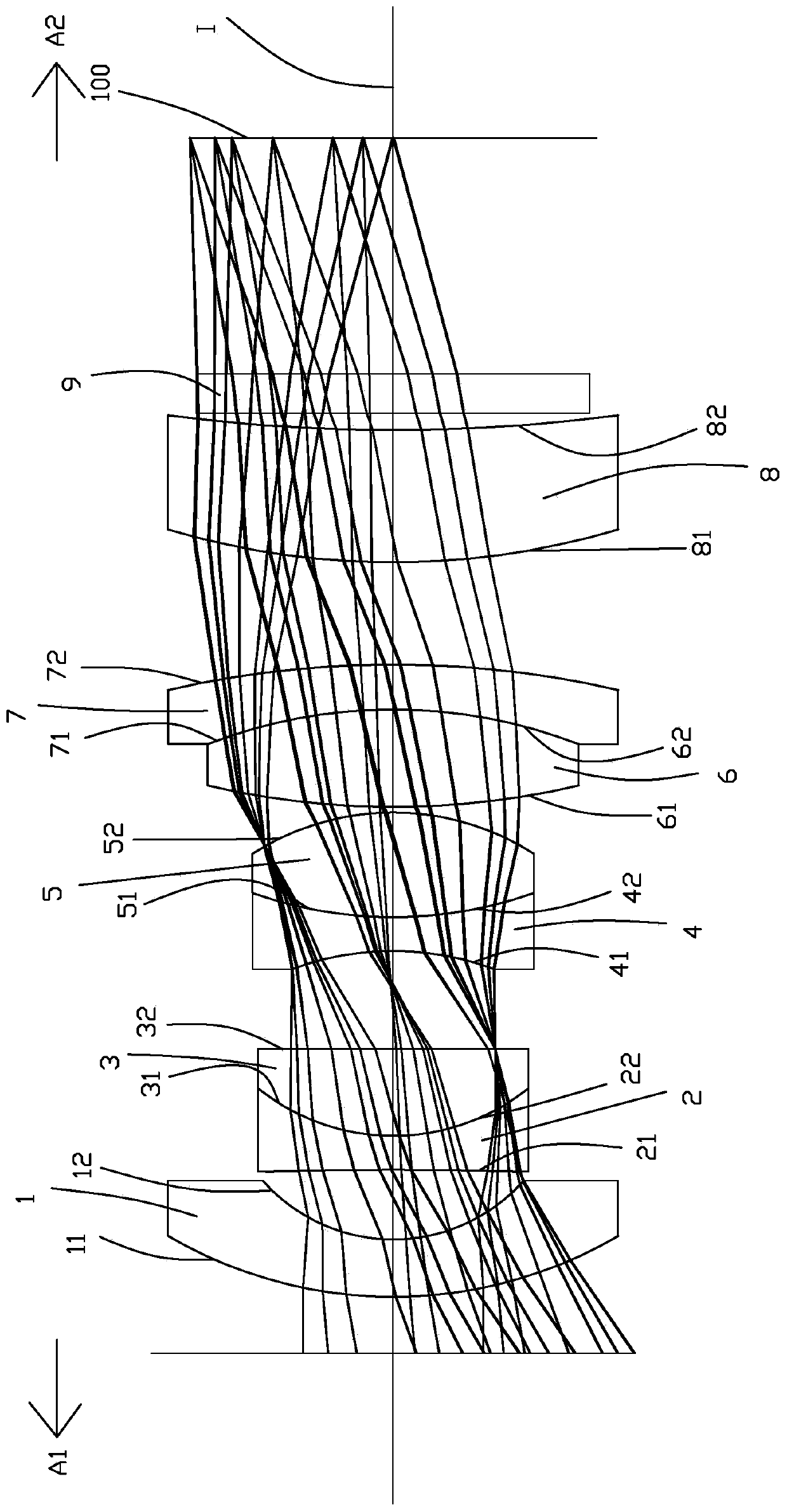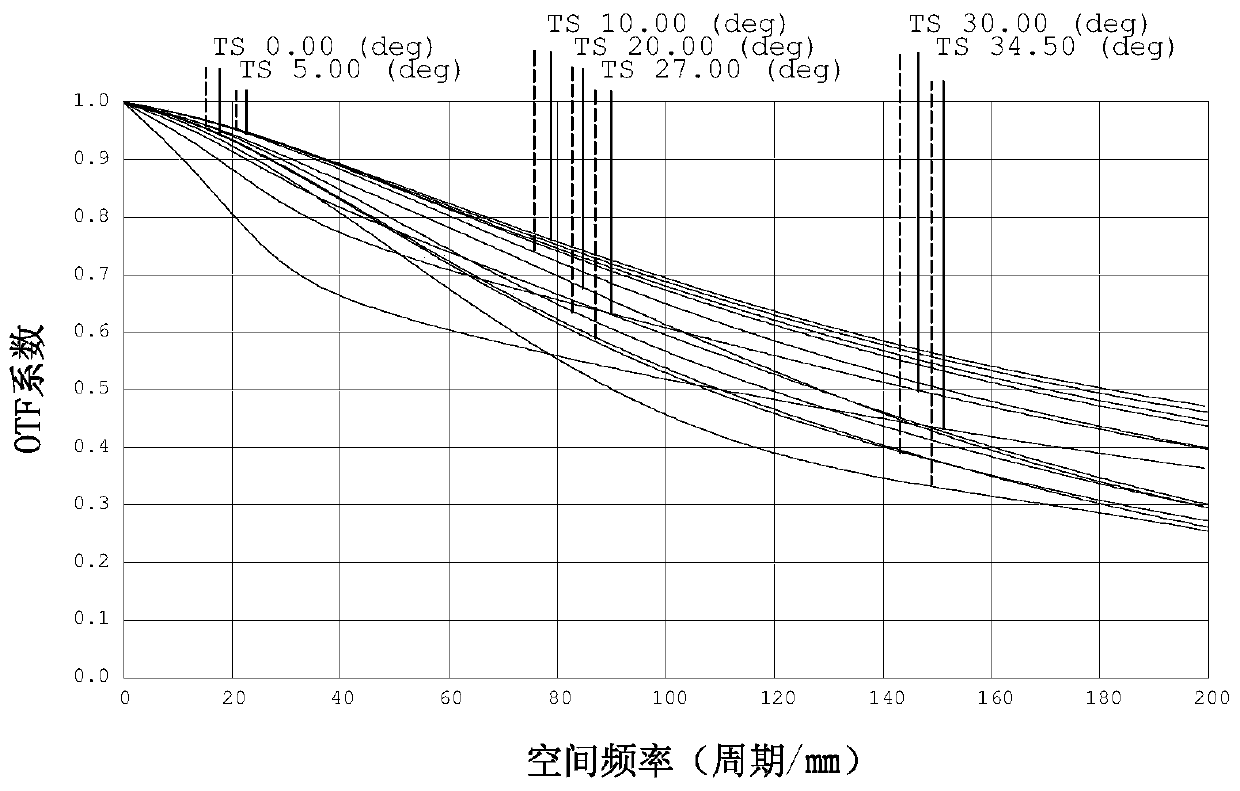Optical imaging lens
An optical imaging lens and lens technology, applied in the field of lenses, can solve the problems of small image area, many lenses, blue-violet fringing, etc., and achieve the effect of large image area and good infrared confocality
- Summary
- Abstract
- Description
- Claims
- Application Information
AI Technical Summary
Problems solved by technology
Method used
Image
Examples
Embodiment 2
[0091] Such as Figure 8 As can be seen, the concave-convex surface and refractive index of each lens in this embodiment and the first embodiment are the same, and only the optical parameters such as the radius of curvature of the lens surface and the thickness of the lens are different.
[0092] The detailed optical data of this specific embodiment are shown in Table 2-1.
[0093] Detailed optical data of Table 2-1 Example 2
[0094] surface Diameter (mm) Radius of curvature (mm) Thickness (mm) material Refractive index Dispersion coefficient focal length(mm) - subject surface Infinity Infinity 11 first lens 8.000 7.793 0.900 H-KF6 1.52 52.19 -10.58 12 4.623 3.098 1.215 21 second lens 4.531 -70.125 0.600 H-K9L 1.52 64.21 -7.01 22 4.800 3.848 0 31 third lens 4.800 3.848 1.540 TAFD25 1.90 31.32 4.23 32 4.800 Infinity 0.000 - aperture ...
Embodiment 3
[0099] Such as Figure 15 As can be seen, the concave-convex surface and refractive index of each lens in this embodiment and the first embodiment are the same, and only the optical parameters such as the radius of curvature of the lens surface and the thickness of the lens are different.
[0100] The detailed optical data of this specific embodiment are shown in Table 3-1.
[0101] Detailed optical data of the third embodiment of table 3-1
[0102] surface Diameter (mm) Radius of curvature (mm) Thickness (mm) material Refractive index Dispersion coefficient focal length(mm) - subject surface Infinity Infinity 11 first lens 5.336 6.260 0.600 H-QK3L 1.49 70.42 -14.18 12 4.332 3.187 1.240 21 second lens 4.135 -27.593 0.600 H-K9L 1.52 64.21 -6.09 22 4.181 3.597 0 31 third lens 4.181 3.597 1.230 H-ZLAF75A 1.90 31.32 3.95 32 3.757 Infinity 0.298 ...
Embodiment 4
[0107] Such as Figure 22 As can be seen, the concave-convex surface and refractive index of each lens in this embodiment and the first embodiment are the same, and only the optical parameters such as the radius of curvature of the lens surface and the thickness of the lens are different.
[0108] The detailed optical data of this specific embodiment are shown in Table 4-1.
[0109] Table 4-1 Detailed optical data of Example 4
[0110] surface Diameter (mm) Radius of curvature (mm) Thickness (mm) material Refractive index Dispersion coefficient focal length(mm) - subject surface Infinity Infinity 11 first lens 8.000 8.146 1.061 H-KF6 1.52 52.19 -10.34 12 4.510 3.095 1.124 21 second lens 4.426 -72.013 0.600 H-K9L 1.52 64.21 -6.61 22 31 third lens 3.990 3.611 1.625 TAFD25 1.90 31.32 3.97 32 3.458 Infinity -0.013 - aperture 3.459 ...
PUM
 Login to View More
Login to View More Abstract
Description
Claims
Application Information
 Login to View More
Login to View More - R&D Engineer
- R&D Manager
- IP Professional
- Industry Leading Data Capabilities
- Powerful AI technology
- Patent DNA Extraction
Browse by: Latest US Patents, China's latest patents, Technical Efficacy Thesaurus, Application Domain, Technology Topic, Popular Technical Reports.
© 2024 PatSnap. All rights reserved.Legal|Privacy policy|Modern Slavery Act Transparency Statement|Sitemap|About US| Contact US: help@patsnap.com










